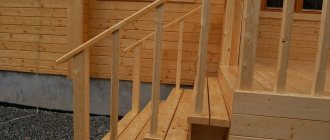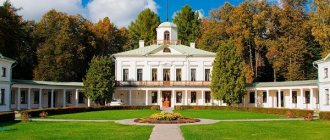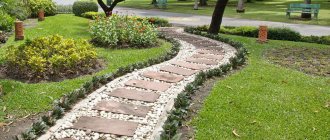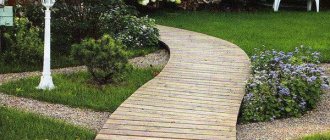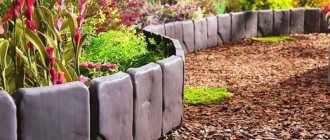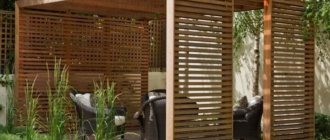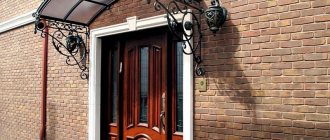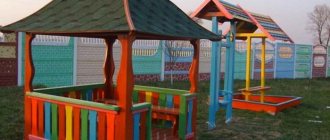The concept of Scandinavian style is associated with something fresh, natural, light and spacious. After all, the Scandinavian countries are Iceland, Norway, Sweden. Their nature is characterized by lush greenery, wide open spaces, and mountain ranges. Now it is fashionable to use the Scandinavian style in landscape design. It is quite simple and assumes the presence of unpretentious plants. Scandinavians everywhere love to decorate their homes with plants; they need at least a small piece of nature in the house.
A Scandinavian garden is easier to create than a Mediterranean or Japanese one. This style assumes the presence of plants from an average climate zone. And those species that grow on the Balkan Peninsula and in Japan may simply not take root in our latitudes.
Source: averus.info
Selecting plants
Scandinavian style in the garden evokes calm and balance. Here it is better to use delicate flowering plants; bright flowers will be placed only as accents.
Scandinavia is a coniferous belt, and therefore these are the trees that predominate in this landscape: conifers, thuja, fir, pine. Flowerbeds can be planted with marigolds, clematis, field poppies, etc. It is important to supplement the garden with interesting elements, for example, cereals.
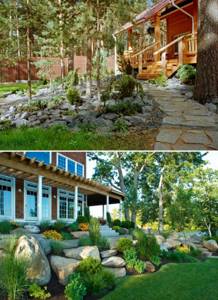
Distinctive features of the Scandinavian style
- Naturalness.
- Orderliness.
- Simplicity.
- Functionality.
- Restraint.
Professionals attribute the Scandinavian style in landscape design to classical fundamentalism. It was formed in harsh conditions - winter for two thirds of the year, depleted soil, a lot of snow and stone, little sun. But this does not prevent him from remaining flexible, multifaceted and alive.
Another striking difference between the Scandinavian style is compactness: a small area (rarely more than 5-10 acres) is combined with aesthetics and emphasized grooming. It harmoniously accommodates small artificial ponds, garden decor, original benches, group plantings of low-growing conifers, green lawns, stone paths, fenced flower beds and flower beds, neat wooden and carefully trimmed low hedges.
Group of Companies "Territory of Country Life"
Scandinavian style in garden landscape design
Scandinavian style in landscape design is distinguished by a skillful combination of simplicity, aesthetics and functionality. Thanks to the thoughtful composition of architectural elements and easy-to-care plants, you will create a Scandinavian atmosphere around your home, a stylish garden that radiates peace and harmony.
The basic principle of organizing space is space and light. There is no room for an excess of unnecessary objects and decorative elements that make the space overcrowded, the garden area is restrained and laconic, everything looks thoughtful and elegant.
Unlike French and English styles, in gardens designed in accordance with Scandinavian principles, naturalness and closeness to nature prevail.
Great importance is attached to sunlight and the choice of colors. The design is dominated by delicate gray or pastel colors. The use of white optically increases the space, imparts lightness and transparency.

The material of architectural elements and decor in accordance with the concept of the garden should be natural and simple - wood, stone, gravel or pebble coverings.
A characteristic common feature of this style are wide terraces made of wood, stone or cement slabs, wooden or stone fences.
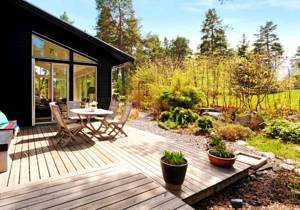
Decorative decorations in a Scandinavian garden tend to be minimal, keeping the design sober and simple and emphasizing the rugged spirit of the region. Their role is played by large stone or clay flowerpots with plants, candles, installations made of natural stones, wood or cobblestones.
The idea of Scandinavian-style landscaping is to make accessories and vegetation reminiscent of the nature of the cold North. For planting, unpretentious plants are recommended, the care of which takes a minimum of time. They must fit harmoniously into the given style, creating a thoughtful garden layout and reflecting the given natural landscape.

Geometric shapes and regular distances between plants are not appropriate. Dry herbs, cereals, coniferous and evergreen trees and shrubs perfectly imitate the Scandinavian atmosphere of the North. Emerald mosses, boulders and gravel paths complement the overall style, making it complete.
In this type of garden, no one is surprised by a small vegetable garden with beds of aromatic herbs and favorite vegetables or large spaces where only stones, ornamental grasses and ground covers reign.

What plants are most often used in Scandinavian landscape design?
Coniferous trees and shrubs of various varieties, undemanding perennials, including ornamental grasses, are ideal for such a simple concept, close to nature.
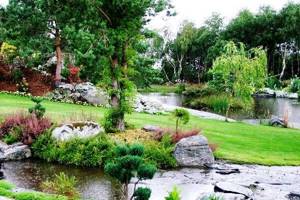
Mandatory species include: low birch, willow, cotoneaster, derain, pine or spruce, juniper, hornbeam, cereals and fragrant heathers. Of the fruit trees, apple trees, pear trees, serviceberry, cranberries, lingonberries, wintergreen and rose hips fit perfectly into the style.
The character of the style is emphasized by floral accents from hanging nasturtiums, geraniums, petunias, and low hydrangea bushes planted in pots. However, it is important not to overdo it with a variety of bright colors.
18.01.2021
Exterior decoration of the house
The facade of a Scandinavian-style house involves simple and natural cladding in neutral colors.
Facade of a private house in Scandinavian style
For the exterior decoration of the walls of a private cottage, wood is mainly chosen. They prefer wood panels or siding. No less relevant is the construction of walls from beams or logs. It is also appropriate to use fiber panels, lining or various boards coated with paint as building materials.
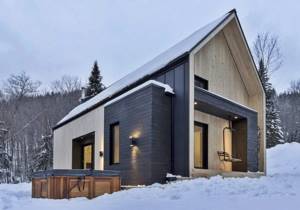
The photo shows the external cladding of a house facade in a Scandinavian style.
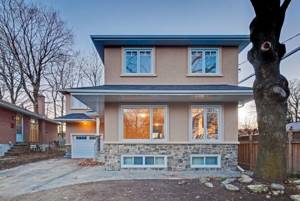
The surface of the walls is often decorated with plaster and laid with artificial or natural stone. This type of finishing can give a stylish and beautiful look to even a simple frame house.
Light exterior cladding will look advantageous in combination with a dark brick foundation and roof.
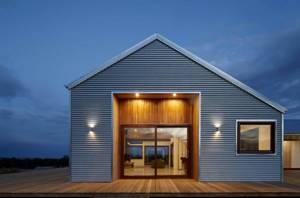
Roof finishing in Scandinavian style
Proper design of the roof gives the exterior an aesthetic and attractive appearance.
- Single-pitch. It may have different levels of inclination, depending on the overall architectural design, landscape design and climate. When finished with high-quality materials, such a roof is resistant to Scandinavian weather conditions. The snow cover falls on the roof in the form of an even layer and creates a uniform and safe load.
- Gable. Thanks to the steep gable roof, there is no need to constantly clean off precipitation.
- Flat. May have a square, rectangular or more complex shape. In order to avoid the accumulation of moisture on the roof surface, correct calculation of slopes and installation of a drainage system is required.
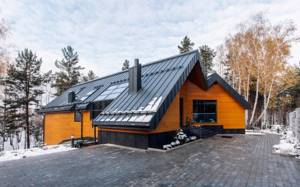
The photo shows a country cottage with a gable roof, finished with metal for painting.
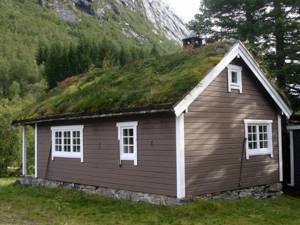
For roofing, it is suitable to use tiles or metal for painting. Due to the harsh northern climate, materials in dark gray or rich brown tones are mainly chosen.
An interesting highlight of country houses in the Scandinavian style is the Norwegian roof. To do this, landscaping the plane with plant cover in the form of lawn grass or even small flower beds is used. This solution not only looks impressive, but also allows for better heat retention.
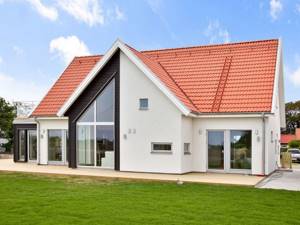
Doors and windows
To ensure maximum daylight penetration into the house, large or panoramic windows are installed. Such openings will give the interior space spaciousness and emphasize the originality of the exterior. The windows are distinguished by fairly massive frames with rough processing and have minimalistic trims that contrast with the facade. Due to the cold and harsh Norwegian winter, warm wooden structures are generally preferred over plastic products.
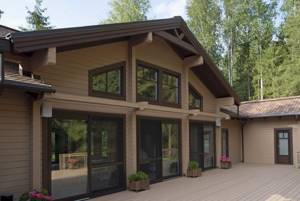
The photo shows the exterior of a beige Norwegian-style cottage with brown windows and doors.
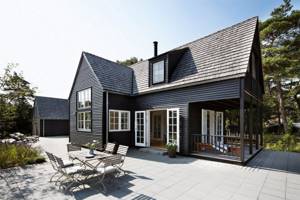
The design of the doors has the same color scheme, shape and design as the window openings. Door leaves can also have panoramic glazing. As an entrance door, it is appropriate to use paneled structures made of solid wood, metal, glued, panel-shaped models or products covered with veneer.
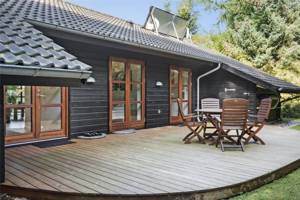
The photo shows the design of wooden entrance doors with glass inserts.
Scandinavian style and its attributes
The Scandinavian garden is characterized by “wild” stone, gravel, granite and all kinds of decorations made of natural wood. The latter are often painted, and if you see that restrained, neutral colors predominate in the garden, then individual elements can be painted more lively and bright. It can be blue, red, orange. Garden benches can be made of stone, brick or wood.
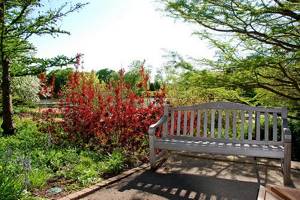
Bench-boxes are also popular, in which you can store all sorts of gardening tools. Benches can be made from different materials. The Scandinavian garden is often called a “container garden” because of these benches. Garden furniture is usually wooden or wicker. Scandinavian style “loves” weaving. Interesting screens, wicker baskets, or stylized garden figures will take a very honorable place in such a garden.
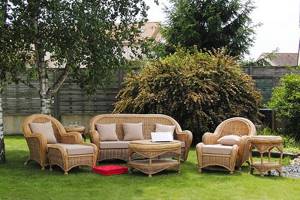
Design in the Scandinavian style also implies the use of household items from the past - cart wheels, old equipment, large half-broken clay jugs, watering cans.
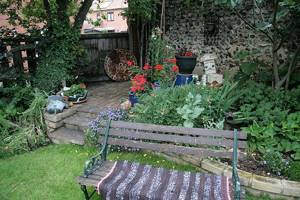
The most suitable plot size for setting up a garden in this style is from 5 to 7 acres. The platforms must be rectangular, preferably made of natural stone. In such a garden, regular, square shapes predominate.
Be sure to have a small plot for a vegetable garden and a small lawn with lilies. An artificial pond can be replaced with a very large, roughly made tub of water. The design of a Scandinavian garden will beautifully fit large blocks of unprocessed wild stone, scattered in creative disorder without any special system - anyone who is familiar with northern culture will probably understand why such Scandinavian motifs are very significant.
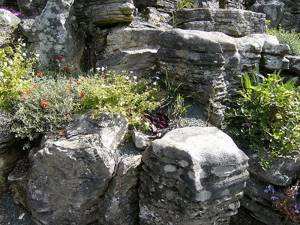
A rather unusual solution would be to fence the garden with huge wild stones.
Adviсe
- Considering the nature of Scandinavia, when creating a garden in this style, use a large number of stones of different sizes and colors, which are laid out in groups or one at a time. The stones should be natural and varied so that the garden does not look boring and monotonous.
- Paths between zones are made of gravel or flat chopped stone. You can also use wooden saw cuts or homemade concrete tiles of different configurations.
- Often in the garden you can see a pond decorated in the same style. The birch tree of the pond is decorated with stones and perennial herbaceous plants are planted. In the middle of the pond you can make a stone mountain topped with a waterfall or a decorative statue.
- It would not be superfluous to build a platform with a fireplace function, on which a barbecue or grill, massive wooden tables and benches and a place for firewood are placed. Such a platform can be round, square or any shape. You can lay out a place for a live fire in the center of the site, decorating it with stones. This could be a large metal vat embedded in the ground, inside which a fire is lit. Rough log benches are placed around the vat.
- When designing a Scandinavian garden, use all the objects located on the site, adapting them to this style. There is no need to remove old trees and bushes. Even a dry stump can become a decorative item.
- Place old curiosities on your property, such as a spindle, barrels or cart wheel, old chrome shoes or other items.
- If you want to make a vegetable garden out of one zone of your plot, you should divide it into beds that will look like flower beds and framed by a low stone border. An important condition is that such a vegetable garden must have a decorative appearance and be neat. Inside the garden, you can plant crops not in a strict linear order, but in zigzags or semicircles, grouping different species, thus creating a decorative bed.
- Climbing plants, such as honeysuckle, akebia, wisteria, ivy, hydrangea, clematis or others, are used as a fence between zones of a garden plot. They are also used to decorate gazebos and camouflage the walls of outbuildings.
Plants used in the Scandinavian garden
The Scandinavian garden is divided into zones, within each of which different types of plants are planted. The zones are separated by rectangular gravel paths. Plants are selected relative to each zone. In the natural oasis zone, inside which ponds, wooden or stone sculptures are placed, perennial shrubs, evergreen trees and field plants are planted.
One of the zones may be a vegetable garden where cultivated food plants are planted. Bushes of barberry, honeysuckle or bladderwort are suitable as hedges. Some areas may include flower beds or large pots of flowers. In the Scandinavian style, the following plants are most often used:
- Calendula
- Ivy
- Marigold
- Delphinium
- Bells
- Daisies
- Clematis
- Field poppies
Of the wildflowers, cereals, lavender, cornflower, chamomile, and field poppies are often found. Trees include maples, conifers (pine, thuja, dwarf spruce), lilac, jasmine and others. Plants that grow quickly are planted in large pots with fertile soil. If they are planted in plastic flowerpots, they are placed inside wicker baskets or birch bark boxes. Low-growing shrubs and trees are very common in Scandinavian gardens. They are planted singly near the wall of a house or fence. Children's swings or bird feeders are hung on tall trees.
When choosing plants, you should give preference to weeping species, such as rowan or birch, as well as evergreen coniferous plants. If you want to plant fruit trees on your site, you should consider how harmoniously they will fit into the overall picture. If possible, the garden is laid out in the background of the landscape. Even cultivated bushes of gooseberries, raspberries and currants can be made decorative. To do this, they are planted in a row and trimmed like a hedge.
When choosing flowering bushes, you should give preference to white or calm pastel tones of flowers. Plants should be easy to care for and harmoniously complement each other. Primroses such as crocus or snowdrops should be planted randomly, creating the appearance of “random” growth in this place.

Scandinavian design
At its core, the Scandinavian style follows the standards of minimalism, but it still has a special northern accent. It manifests itself in a special attitude towards everything natural, because Scandinavians have a rare opportunity to admire the living, blooming manifestations of nature. Simple-looking Scandinavian gardens create a special coziness inside.
Basic techniques of Scandinavian landscape design.
- Wooden gazebos and arches covered with creeping plants (clematis, ivy).
- Spacious lawns with individual plantings.
- Lawns with wildflowers, heather, cereals.
- Wooden garden figurines from Scandinavian myths (gnomes, trolls).
- Green hedges.
- Paths and platforms paved with stone.
- Container flower beds.
Structures and buildings
Scandinavian landscape design involves not only a large house with a terrace on the site, but also other buildings for economic, decorative and functional purposes. The basic rule is that they should be medium in size (not bulky), and their finishing should be made of natural stone and wood (it can be painted in different shades). They are often supplemented with wickerwork. This can be not only furniture, but also finishing elements, wicker figurines, flower bed fencing, etc.
A gazebo (arbor) with a barbecue, a bathhouse, and a summer kitchen, decorated in the “dwarf house” version, looks very organic.
A maximum of flower beds with bright flowers are planted next to any structure.

